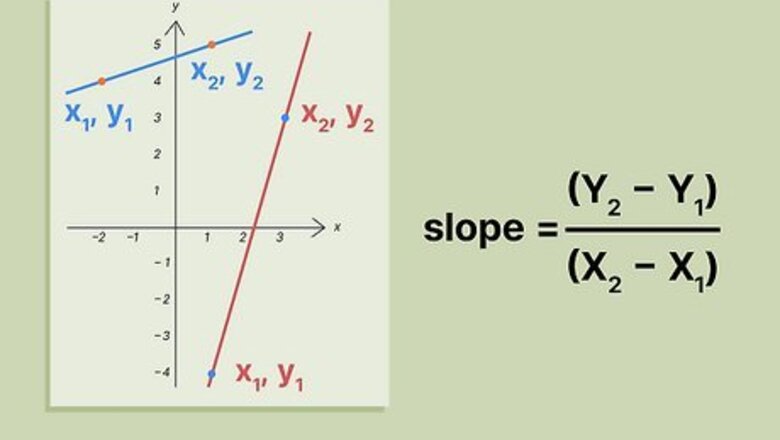
views
X
Research source
A key feature of parallel lines is that they have identical slopes.[2]
X
Research source
The slope of a line is defined as the rise (change in Y coordinates) over the run (change in X coordinates) of a line, in other words how steep the line is.[3]
X
Research source
Parallel lines are most commonly represented by two vertical lines (ll). For example, ABllCD indicates that line AB is parallel to CD.
Comparing the Slopes of Each Line
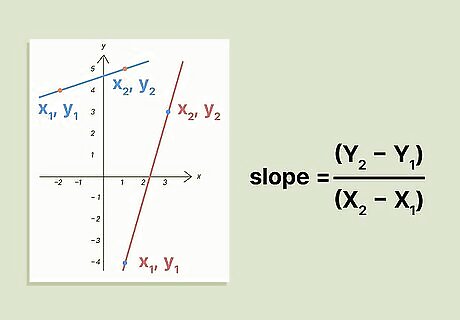
Define the formula for slope. The slope of a line is defined by (Y2 - Y1)/(X2 - X1) where X and Y are the horizontal and vertical coordinates of points on the line. You must define two points on the line to calculate this formula. The point closer to the bottom of the line is (X1, Y1) and the point higher on the line, above the first point, is (X2, Y2). This formula can be restated as the rise over the run. It is the change in vertical difference over the change in horizontal difference, or the steepness of the line. If a line points upwards to the right, it will have a positive slope. If the line is downwards to the right, it will have a negative slope.
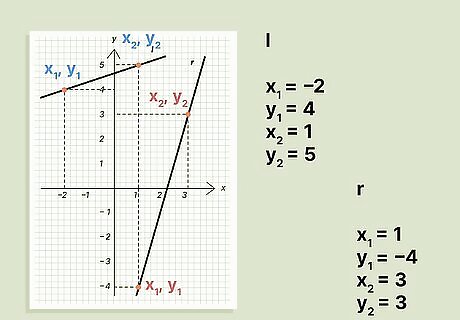
Identify the X and Y coordinates of two points on each line. A point on a line is given by the coordinate (X, Y) where X is the location on the horizontal axis and Y is the location on the vertical axis. To calculate the slope, you need to identify two points on each of the lines in question. Points are easily determined when you have a line drawn on graphing paper. To define a point, draw a dashed line up from the horizontal axis until it intersects the line. The position that you started the line on the horizontal axis is the X coordinate, while the Y coordinate is where the dashed line intersects the line on the vertical axis. For example: line l has the points (1, 5) and (-2, 4) while line r has the points (3, 3) and (1, -4).
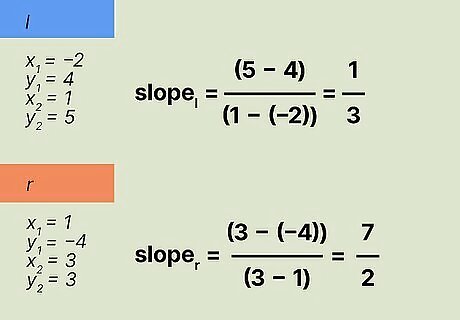
Plug the points for each line into the slope formula. To actually calculate the slope, simply plug in the numbers, subtract, and then divide. Take care to plug in the coordinates to the proper X and Y value in the formula. To calculate the slope of line l: slope = (5 – 4)/(1 – (-2)) Subtract: slope = 1/3 The slope of line r is: slope = (3 – (-4))/(3 - 1) = 7/2
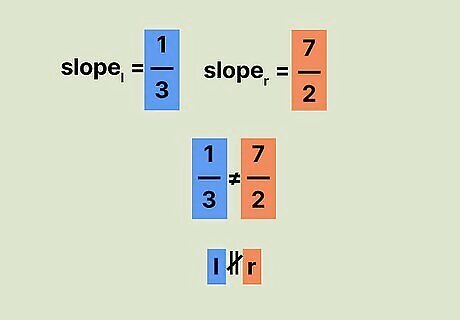
Compare the slopes of each line. Remember, two lines are parallel only if they have identical slopes. Lines may look parallel on paper and may even be very close to parallel, but if their slopes are not exactly the same, they aren’t parallel. In this example, 1/3 is not equal to 7/2, therefore, these two lines are not parallel.
Using the Slope-Intercept Formula
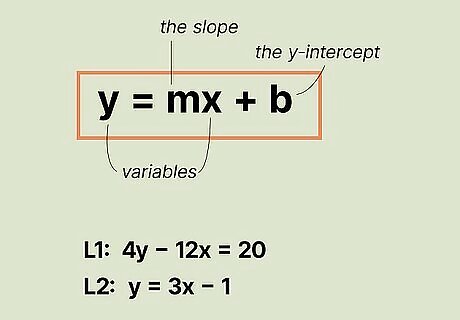
Define the slope-intercept formula of a line. The formula of a line in slope-intercept form is y = mx + b, where m is the slope, b is the y-intercept, and x and y are variables that represent coordinates on the line; generally, you will see them remain as x and y in the equation. In this form, you can easily determine the slope of the line as the variable "m". For example. Rewrite 4y - 12x = 20 and y = 3x -1. The equation 4y - 12x = 20 needs to be rewritten with algebra while y = 3x -1 is already in slope-intercept form and does not need to be rearranged.
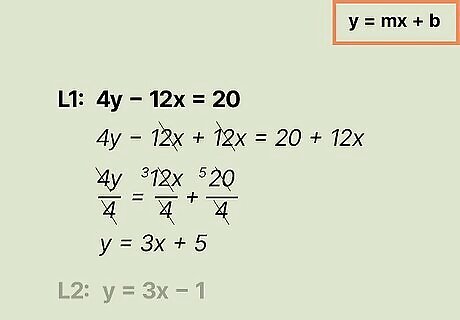
Rewrite the formula of the line in slope-intercept form. Oftentimes, the formula of the line you are given will not be in slope-intercept form. It only takes a little math and rearranging of variables to get it into slope-intercept. For example: Rewrite line 4y-12x=20 into slope-intercept form. Add 12x to both sides of the equation: 4y – 12x + 12x = 20 + 12x Divide each side by 4 to get y on its own: 4y/4 = 12x/4 +20/4 Slope-intercept form: y = 3x + 5.

Compare the slopes of each line. Remember, when two lines are parallel to each other, they will have the exact same slope. Using the equation y = mx + b where m is the slope of the line, you can identify and compare the slopes of two lines. In our example, the first line has an equation of y = 3x + 5, therefore it’s slope is 3. The other line has an equation of y = 3x – 1 which also has a slope of 3. Since the slopes are identical, these two lines are parallel. Note that if these equations had the same y-intercept, they would be the same line instead of parallel.
Defining a Parallel Line with the Point-Slope Equation
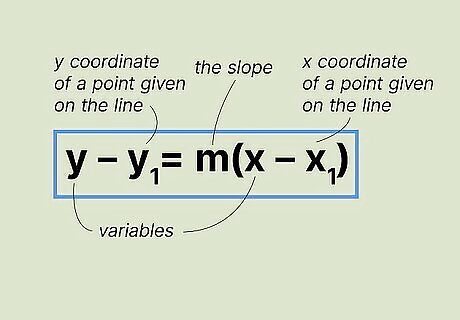
Define the point-slope equation. Point-slope form allows you to write the equation of a line when you know its slope and have an (x, y) coordinate. You would use this formula when you want to define a second parallel line to an already given line with a defined slope. The formula is y – y1= m(x – x1) where m is the slope of the line, x1 is the x coordinate of a point given on the line and y1 is the y coordinate of that point. As in the slope-intercept equation, x and y are variables that represent coordinates on the line; generally, you will see them remain as x and y in the equation. The following steps will work through this example: Write the equation of a line parallel to the line y = -4x + 3 that goes through point (1, -2).

Determine the slope of the first line. When writing the equation of a new line, you must first identify the slope of the line you want to draw yours parallel to. Make sure the equation of the original line is in slope-intercept form and then you know the slope (m). The line we want to draw parallel to is y = -4x + 3. In this equation, -4 represents the variable m and therefore, is the slope of the line.
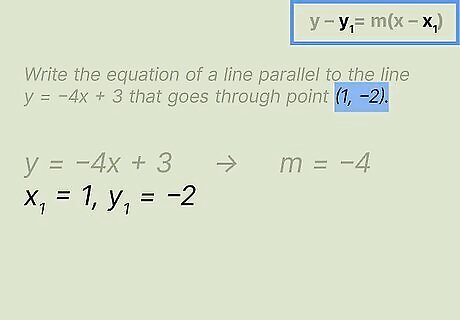
Identify a point on the new line. This equation only works if you have a coordinate that passes through the new line. Make sure you don’t choose a coordinate that is on the original line. If your final equations have the same y-intercept, they are not parallel, but the same line. In our example, we will use the coordinate (1, -2).
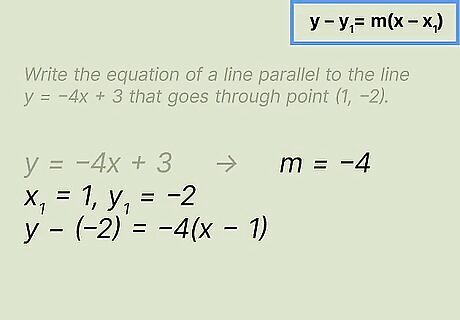
Write the equation of the new line with the point-slope form. Remember the formula is y – y1= m(x – x1). Plug in the slope and coordinates of your point to write the equation of your new line that is parallel to the first. Using our example with slope (m) -4 and (x, y) coordinate (1, -2): y – (-2) = -4(x – 1)
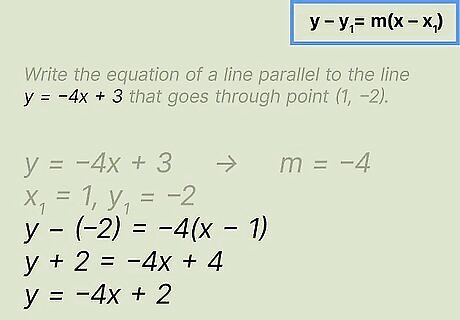
Simplify the equation. After you have plugged in the numbers, the equation can be simplified into the more common slope-intercept form. This equation's line, if graphed on a coordinate plane, would be parallel to the given equation. For example: y – (-2) = -4(x – 1) Two negatives make a positive: y + 2 = -4(x -1) Distribute the -4 to x and -1: y + 2 = -4x + 4. Subtract -2 from both side: y + 2 – 2 = -4x + 4 – 2 Simplified equation: y = -4x + 2



















Comments
0 comment